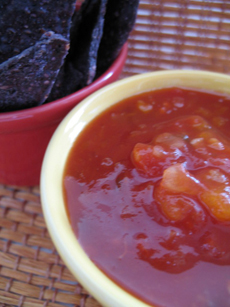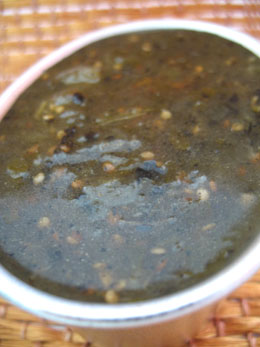

Cherry Salsa from Traverse Bay. Photo by Melody Lan | THE NIBBLE.
|
KAREN HOCHMAN is Editorial Director of THE NIBBLE.
|
|
May 2007
Updated August 2009
|
 |
The History Of Salsa
Page 3: Salsa Chronology/Salsa Dance
This is Page 3 of a three-page article. Click on the black links below to visit other pages.
Salsa Chronology, Continued
- In the 1970s, a new food trend, sometimes called the “whole foods movement,” sweeps the country, emphasizing cooking with fresh, unadulterated ingredients. “California cuisine” is born, vegetarianism increases in popularity, health food stores and gourmet retailers (specialty food stores) spring up to sell specialty foods that are not available in supermarkets.
- In 1975, Patti Swidler of Arizona launches Desert Rose Salsa. Four years later, in Austin, Texas, Dan Jardine begins producing D.L. Jardine’s Salsa, giving Austin the reputation as the hot sauce capital of America.
- 1980, Norma and W. Park Kerr launch the El Paso Chile Company in Texas. In 1986, Miguel’s Stowe Away in Vermont launches a salsa line. In April, 1986, Sauces & Salsas Ltd. begins manufacturing the Montezuma brand of hot pepper sauces and salsas in Ohio. [4]
- In 1987, Pace, the market leader, sees major competition as Hormel & Co., licenses the Chi-Chi’s restaurant name and introduces the Chi-Chi’s brand, which will eventually capture a large share of the market. The same year, Robert Spiegel, Dave DeWitt and Nancy Gerlach found Chile Pepper magazine for fiery food lovers.
- In 1988, Lisa Lammé opens Le Saucier in Boston, believed to be the first retail shop specializing in hot sauces.
|
|

Salsa verde is an early salsa made not from the
tomato but from the tomatillo, a member of the same family as the tomato (the Nightshades) but closer in relation to the cape gooseberry. |
- Between 1985 and 1990, Mexican sauce sales grow 79%. Between 1988 and 1992, the percentage of American households buying salsa increases from 16% to 36%.
- In 1991, salsa overtakes ketchup as the top-selling condiment in the U.S. in total dollar sales.
- By 1992, the top eight salsa manufacturers are Pace, Old El Paso (owned by Pet Foods), Frito-Lay, Chi-Chi’s (Hormel), La Victoria, Ortega, Herdez and Newman’s Own. Pace commands 32.3% of the market, according to a study by Information Resources, Inc., and published in The New York Times. [6]
- In 1994, the number one salsa manufacturer, Pace Foods, sells to Campbell Soup Company for an astronomical $1.1 billion on sales of $220 million. In even a larger deal, Pillsbury announces that it will purchase Pet Foods, maker of Old El Paso Mexican Foods, for $2.6 billion. Together, Pace and Pet Foods control about half of the market for Mexican sauces. [4]
- By 2000, more households buy salsa than bought ketchup.[7]
From a health standpoint, that’s good. Ketchup is loaded with sugar; salsa generally has none (except for fruit salsas, which typically have no added sugar). Salsa is low in calories and contains little to no fat. Tomatoes, chiles and cilantro contain vitamins A and C; tomatoes also have potassium.
[4] http://www.buzzle.com/editorials/6-20-2006-99913.asp
[6] http://www.fiery-foods.com/dave/history.html
[7] http://www.davespepperpalace.com/
[8] 21 May 1931 New Orleans Times-Picayune,
http://listserv.linguistlist.org/cgi-bin/wa?A2=ind0306d&L=ads-l&P=1729
Salsa, The Dance
In 1933 Cuban songwriter Ignacio Piniero wrote the song “Echale Salsita” (“Throw On Some Sauce”) after tasting food which lacked Cuban spices. But it was in 1962 that Jimmy Sabater’s tune “Salsa y Beme” suggested that dancers spice it up by adding a little “salsa” to their movement when they danced. Sabater is a bilingual vocalist, percussionist and composer, born of Puerto Rican parents in the El Barrio section of Harlem (Spanish Harlem).
As salsa denotes a spicy or hot flavor, salsa is a hot and spicy dance to a variety of Afro-Latin rhythms driven by the clave (two wooden sticks struck together). Many of the salsa dance patterns are closely related to those of the mambo. Salsa is the national music and dance of Puerto Rico.
WANT TO BECOME A SALSA (THE FOOD) EXPERT?
Take a look at our Salsa Glossary, with more than
30 different definitions and types of salsa! |

|





